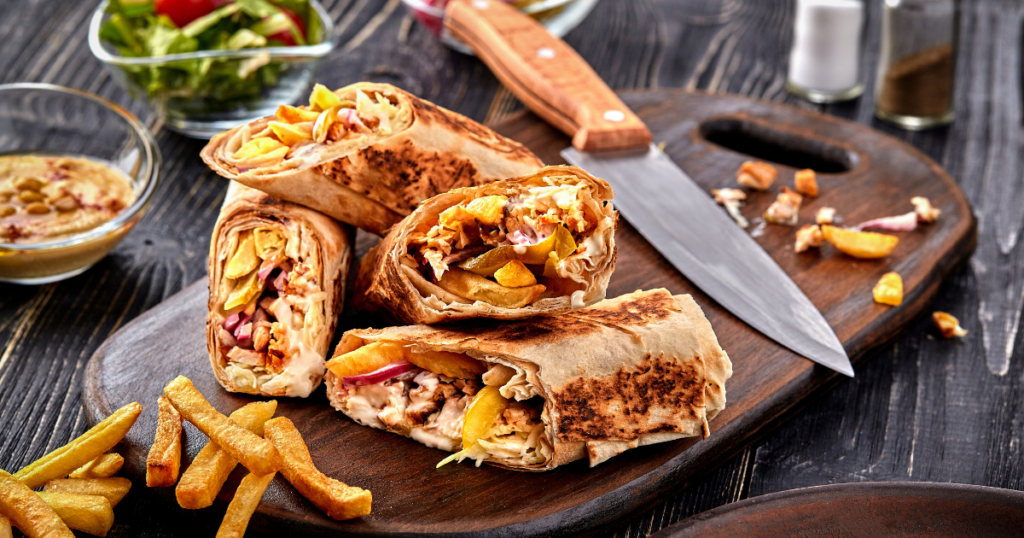Few street foods have captured the hearts (and taste buds) of food lovers worldwide quite like shawarma. This iconic dish, defined by thinly sliced, marinated meat cooked to perfection on a vertical rotisserie, is as much a culinary experience as it is a cultural phenomenon. Traditionally served in wraps, pita bread, or plates alongside fresh vegetables, tangy sauces, and pickled condiments, shawarma is a perfect blend of savory flavors and mouthwatering aromas.
Its universal appeal is a testament to its versatility, as it adapts to the culinary preferences of diverse regions. But what are the origins of shawarma, and how did it become the global sensation it is today? To uncover the story, we delve into its roots in the Middle East and follow its journey through history and geography.
The Early History of Shawarma Origin
History of shawarma starts from Middle East, specifically to the Ottoman Empire, in what is now modern-day Turkey. The term “shawarma” itself is derived from the Turkish word “çevirme,” which means “to turn,” aptly describing the vertical rotisserie method used to cook the meat.
During the 18th and 19th centuries, Ottoman chefs pioneered the concept of vertically roasting meat. This method involved stacking marinated slices of lamb, beef, or chicken on a skewer and cooking it slowly over an open flame. The rotisserie allowed the outer layers of meat to crisp up while retaining their juices, creating a delectable texture that made the dish a favorite among locals and travelers alike.
The innovation of slicing the meat thinly as it cooked further elevated its appeal, making it convenient to serve in bread or on plates. By the early 20th century, this cooking style had spread across the Levant region, where it was adapted to local tastes and became the foundation for what we now recognize as shawarma.
Regional Variations from Shawarma Origin Around the World
As shawarma traveled beyond its Middle Eastern roots, it evolved to reflect the culinary traditions and flavors of the regions where it gained popularity. Here’s a look at how this beloved dish has been adapted in different parts of the world:
1. Shawarma in the Middle East

In its homeland, shawarma is an everyday favorite and a staple of Middle Eastern street food culture. The traditional version often features lamb or chicken, marinated with a blend of spices such as cumin, coriander, turmeric, and paprika. It’s typically served with tahini sauce, hummus, or garlic paste and paired with fresh vegetables like tomatoes, lettuce, and cucumbers.
Pickled vegetables and fries are also popular accompaniments, adding a tangy and crunchy element to the dish. In countries like Lebanon, Jordan, and Syria, shawarma is often wrapped in thin pita bread and grilled to enhance its flavors.
2. Shawarma in the Mediterranean

In the Mediterranean, shawarma has merged with local culinary practices to create unique variations. Greek gyros, for example, share similarities with shawarma but use pork as the primary meat and are served with tzatziki sauce. In Israel, shawarma is often made with turkey or lamb and served in laffa, a type of flatbread, with amba (a tangy mango pickle sauce) and chopped salads.
The Mediterranean adaptation often emphasizes fresh herbs, citrus flavors, and lighter accompaniments, reflecting the region’s emphasis on healthy and balanced meals.
3. Shawarma in the West

In the West, shawarma gained traction as part of the broader popularity of Middle Eastern cuisine. It’s widely available in food trucks, restaurants, and street food markets, often tailored to suit local preferences. Beef and chicken are the most commonly used meats, though vegetarian and vegan versions made with falafel or grilled vegetables have also gained popularity.
In North America, shawarma wraps are often loaded with extra sauces like garlic mayo or hot sauce, catering to a more indulgent palate. Meanwhile, in Europe, shawarma-inspired dishes like the German döner kebab have become late-night street food staples.
Order Delicious Shawarma on Swiggy Today!
Craving the irresistible flavors of shawarma? With Swiggy, you can enjoy this Middle Eastern delight from the comfort of your home. Whether you’re in the mood for a classic lamb shawarma wrap or a modern chicken shawarma plate loaded with veggies and sauces, Swiggy brings authentic and innovative options from your favorite non veg restaurants straight to your doorstep.
Pair your shawarma with sides like hummus, fries, or tabbouleh for a complete meal, or explore fusion varieties that combine shawarma with international flavors. Whatever your preference, Swiggy ensures a convenient and flavorful dining experience fom your list of Shawarma restaurants near me.
Conclusion
Shawarma’s journey from the Ottoman Empire to the streets of cities across the globe is a testament to its timeless appeal and culinary versatility. Rooted in tradition yet endlessly adaptable, it has become a universal favorite that transcends borders and cultures.
Whether you enjoy it wrapped in warm pita bread, served on a plate with fresh accompaniments, or as a modern fusion creation, shawarma continues to captivate food lovers with its rich flavors and hearty satisfaction. Its story, steeped in history and innovation, reminds us of the power of food to connect people and preserve cultural heritage.
So, the next time you savor a bite of shawarma, take a moment to appreciate the journey it has traveled to reach your plate—a journey that began centuries ago in the heart of the Middle East.
FAQ
1. Who was the founder of shawarma?
While there is no single shawarma founder, its origins are attributed to Ottoman chefs who pioneered the vertical rotisserie method of cooking meat in the 18th and 19th centuries.
2. What is shawarma’s origin country?
Shawarma origin country is the Ottoman Empire, specifically modern-day Turkey, where the method of vertically roasting meat was first developed.
3. What kind of meat is used in shawarma?
Traditional shawarma uses lamb or chicken, but variations also include beef, turkey, and goat. In modern adaptations, vegetarian and vegan options like falafel or tofu are also available.
Author Bio
Satisfying your cravings, one bite at a time. Discover the best eats, trends, and uncover the hidden gems with us to make your online ordering or dining experience a memorable one.










































































